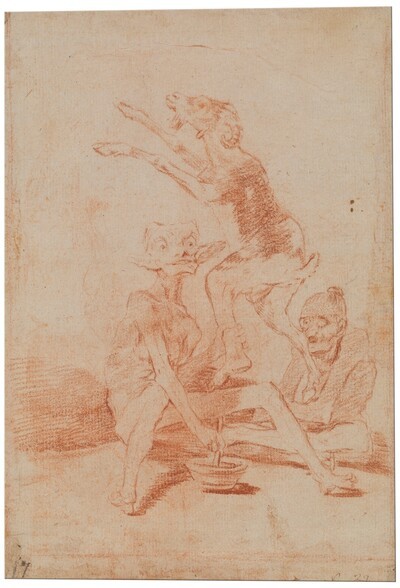- Cronología
- Ca. 1797 - 1799
- Dimensiones
- 218 x 153 mm
- Técnica y soporte
- Etching, burnished aquatint and drypoint
- Reconocimiento de la autoría de Goya
- Undisputed work
- Ficha: realización/revisión
- 09 Jan 2011 / 29 May 2024
- Inventario
- 225
Aguarda que te unten (at the bottom)
67. (in the upper right-hand corner)
See Francisco de Goya y Lucientes, Painter.
A pre-print proof with burnished aquatint and drypoint is preserved in the Bibliothèque Nationale de France, Paris.
A preparatory drawing of this engraving is in the Prado Museum.
An old naked sorcerer with a monstrous face and animal ears applies an ointment to a character with a brush. Thanks to this substance, the latter has become a billy goat trying to take flight. However, there is still something human about him: the leg by which the sorcerer grabs him, where he has not yet spread the potion. Next to them stands a one-eyed woman with a one-eyed body and a worn face, who watches the scene attentively.
With the burnisher Goya has created a large triangle of light behind the figures, above which is another half-tone triangle. The bodies of the figures, especially that of the goat about to take flight, and the ground on the left side of the print, are rendered with precision in etching.
In the Ayala manuscript the engraving is explained as an Extreme-Unction, while in the Prado manuscript a more detailed interpretation is given: "They send him on an important errand and he wants to leave half smeared; among the witches there are also trunks, hasty, boastful, without a shred of judgement; everyone is a country". Finally, the manuscript of the National Library gives us the following description of the print: "With the spread of ignorance and clumsiness, men become bastards in the end". (The Extreme-Unction).
It is possible that one of Goya's sources of inspiration for this engraving was the Tragicomedy of Lysander and Rosalia or Second Celestina (1534) by Feliciano de Silva (Ciudad Rodrigo, 1482/1492-1554). This theme also appears in the Auto de fe held in the city of Logroño on 6 and 7 November 1610.
As in many other scenes of witchcraft in the Caprices series, in this print the dreamlike prevails over the critical content. Goya has taken great care with the composition and has recreated the faces of the characters, especially the one in the foreground, to provide us with a surprising image drawn from his fantasy. It looks more like a Goyaesque amusement than an image intended for censorship.
The plate is in rather poor condition, with the aquatint very worn (National Chalcography, no. 238).
-
Goya. La década de Los CaprichosMadrid1992organized by Real Academia de Bellas Artes de San Fernando sponsored by Fundación Central Hispano, Madrid, consultant editor Nigel Glendinnig. From October 26th 1992 to January 10th 1993cat. 64
-
Francisco de GoyaMuseo d'Arte ModernaLugano1996exhibition celebrated from September 22nd to November 17th.cat. 67, p.94
-
Francisco Goya. Sein leben im spiegel der graphik. Fuendetodos 1746-1828 Bordeaux. 1746-1996Galerie KornfeldBern1996from November 21st 1996 to January 1997cat. 73
-
Goya e la tradizione italianaFondazione Magnani RoccaMamiano di Traversetolo (Parma)2006consultant editors Fred Licht and Simona Tosini Pizzetti. From September 9th to December 3th 2006cat. 67, p.162
-
Goya. Opera graficaPinacoteca del Castello di San GiorgioLegnano2006exhibition celebrated from December 16th 2006 to April 1st 2007p.41
-
Goya et la modernitéPinacothèque de ParisParís2013from October 11st 2013 to March 16th 2014cat. 170
-
2022
-
Goya engravings and lithographs, vol. I y II.OxfordBruno Cassirer1964p.144, cat. 102
-
Vie et ouvre de Francisco de GoyaParísOffice du livre1970p.183, cat. 585
-
Goya, la década de los caprichos: dibujos y aguafuertesMadridReal Academia de Bellas Artes de San Fernando1992pp.108-109, cat. 64
-
Goya. El capricho y la invención. Cuadros de gabinete, bocetos y miniaturasMadridMuseo del Prado1993pp.213-214, fig. 154
-
Catálogo de las estampas de Goya en la Biblioteca NacionalMadridMinisterio de Educación y Cultura, Biblioteca Nacional1996p.110, cat. 159
-
El libro de los caprichos: dos siglos de interpretaciones (1799-1999). Catálogo de los dibujos, pruebas de estado, láminas de cobre y estampas de la primera ediciónMadridMuseo Nacional del Prado1999pp.338-341
-
ParísPinacoteca de París2013p. 235
-
Goya. In the Norton Simon MuseumPasadenaNorton Simon Museum2016pp. 42-75
-
Museo de Bellas Artes de Badajoz y Diputación de Badajoz2022p. 48

